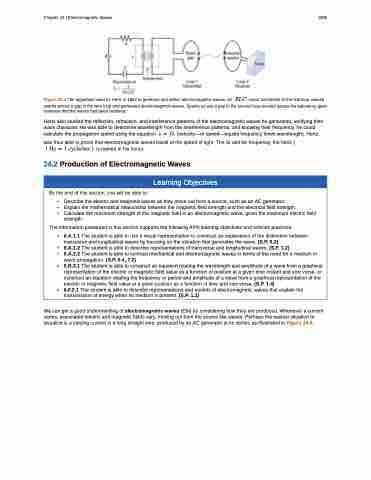Page 1097 - College Physics For AP Courses
P. 1097
Chapter 24 | Electromagnetic Waves 1085
Figure 24.4 The apparatus used by Hertz in 1887 to generate and detect electromagnetic waves. An ��� circuit connected to the first loop caused sparks across a gap in the wire loop and generated electromagnetic waves. Sparks across a gap in the second loop located across the laboratory gave
evidence that the waves had been received.
Hertz also studied the reflection, refraction, and interference patterns of the electromagnetic waves he generated, verifying their wave character. He was able to determine wavelength from the interference patterns, and knowing their frequency, he could calculate the propagation speed using the equation � � �� (velocity—or speed—equals frequency times wavelength). Hertz
was thus able to prove that electromagnetic waves travel at the speed of light. The SI unit for frequency, the hertz ( � �� � � ��������� ), is named in his honor.
24.2 Production of Electromagnetic Waves
Learning Objectives
By the end of this section, you will be able to:
• Describe the electric and magnetic waves as they move out from a source, such as an AC generator.
• Explain the mathematical relationship between the magnetic field strength and the electrical field strength.
• Calculate the maximum strength of the magnetic field in an electromagnetic wave, given the maximum electric field
strength.
The information presented in this section supports the following AP® learning objectives and science practices:
• 6.A.1.1 The student is able to use a visual representation to construct an explanation of the distinction between transverse and longitudinal waves by focusing on the vibration that generates the wave. (S.P. 6.2)
• 6.A.1.2 The student is able to describe representations of transverse and longitudinal waves. (S.P. 1.2)
• 6.A.2.2 The student is able to contrast mechanical and electromagnetic waves in terms of the need for a medium in
wave propagation. (S.P. 6.4, 7.2)
• 6.B.3.1 The student is able to construct an equation relating the wavelength and amplitude of a wave from a graphical
representation of the electric or magnetic field value as a function of position at a given time instant and vice versa, or construct an equation relating the frequency or period and amplitude of a wave from a graphical representation of the electric or magnetic field value at a given position as a function of time and vice versa. (S.P. 1.4)
• 6.F.2.1 The student is able to describe representations and models of electromagnetic waves that explain the transmission of energy when no medium is present. (S.P. 1.1)
We can get a good understanding of electromagnetic waves (EM) by considering how they are produced. Whenever a current varies, associated electric and magnetic fields vary, moving out from the source like waves. Perhaps the easiest situation to visualize is a varying current in a long straight wire, produced by an AC generator at its center, as illustrated in Figure 24.5.


